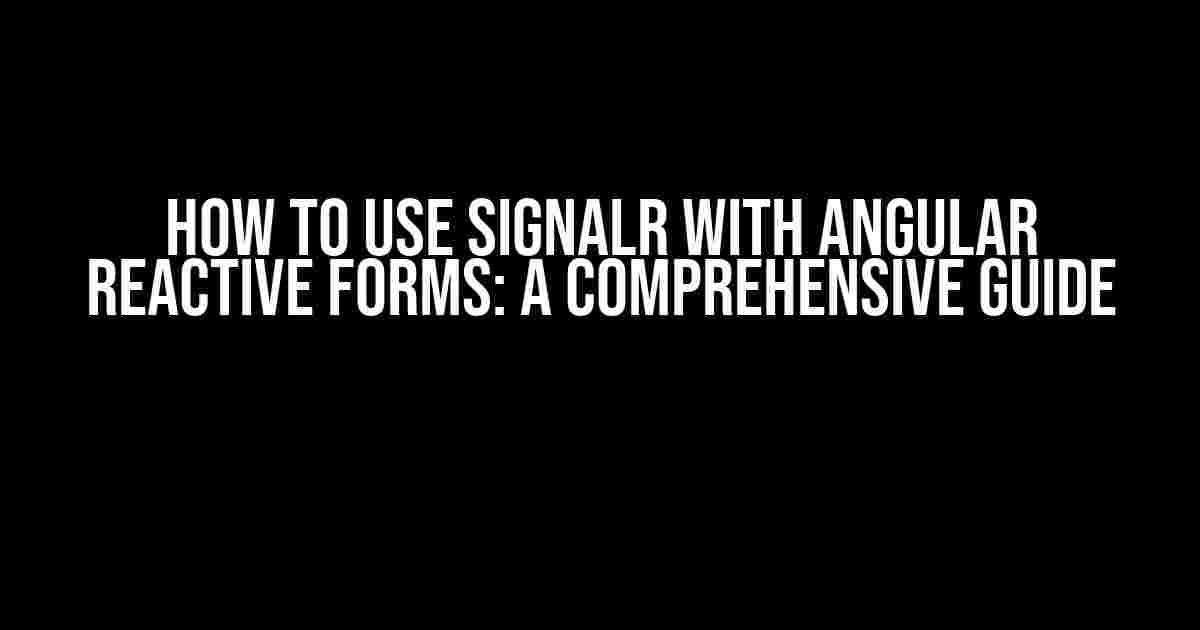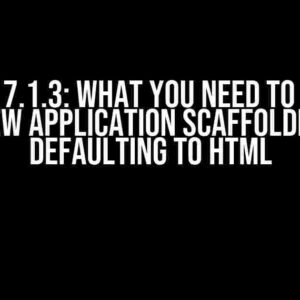Are you tired of dealing with tedious form submissions and slow updates in your Angular application? Look no further! In this article, we’ll explore the power of SignalR and how to use it with Angular Reactive Forms to create a seamless and real-time user experience.
What is SignalR?
SignalR is a library developed by Microsoft that enables real-time communication between a server and connected clients. It’s built on top of the ASP.NET framework and allows developers to push content from the server to connected clients, eliminating the need for traditional polling or long-polling techniques.
Why Use SignalR with Angular Reactive Forms?
Angular Reactive Forms provide a powerful way to manage form data and validate user input. However, when it comes to sending form data to the server, traditional HTTP requests can lead to slow updates and poor user experience. By integrating SignalR with Angular Reactive Forms, you can create a real-time feedback loop between the client and server, enabling instant form validation, auto-saving, and collaborative editing.
Setting Up the Project
To get started, create a new Angular project using the Angular CLI:
ng new signalr-forms-appNext, install the required dependencies:
npm install @aspnet/signalr @types/signalrConfiguring SignalR
In the `app.module.ts` file, add the SignalR module:
import { BrowserModule } from '@angular/platform-browser';
import { NgModule } from '@angular/core';
import { HttpClientModule } from '@angular/common/http';
import { SignalRModule } from '@aspnet/signalr';
@NgModule({
declarations: [AppComponent],
imports: [
BrowserModule,
HttpClientModule,
SignalRModule.forRoot(['http://localhost:5000/hubs'])
],
providers: [],
bootstrap: [AppComponent]
})
export class AppModule {}In the above code, we’re importing the `SignalRModule` and configuring it to connect to our SignalR hub at `http://localhost:5000/hubs`.
Creating the Form Component
Create a new component for our form:
ng generate component formIn the `form.component.html` file, add the following code:
<form [formGroup]="form">
<label>Name:</label>
<input formControlName="name">
<br>
<label>Email:</label>
<input formControlName="email">
<br>
<button (click)="submitForm()">Submit</button>
</form>In the `form.component.ts` file, add the following code:
import { Component, OnInit } from '@angular/core';
import { FormGroup, FormControl, Validators } from '@angular/forms';
import { HubConnection } from '@aspnet/signalr';
@Component({
selector: 'app-form',
templateUrl: './form.component.html',
styleUrls: ['./form.component.css']
})
export class FormComponent implements OnInit {
form: FormGroup;
constructor(private hubConnection: HubConnection) { }
ngOnInit(): void {
this.form = new FormGroup({
name: new FormControl('', Validators.required),
email: new FormControl('', Validators.required)
});
}
submitForm(): void {
// We'll send the form data to the server using SignalR
}
}Integrating SignalR with the Form Component
In the `form.component.ts` file, add the following code to send the form data to the server using SignalR:
import { Component, OnInit } from '@angular/core';
import { FormGroup, FormControl, Validators } from '@angular/forms';
import { HubConnection } from '@aspnet/signalr';
@Component({
selector: 'app-form',
templateUrl: './form.component.html',
styleUrls: ['./form.component.css']
})
export class FormComponent implements OnInit {
form: FormGroup;
constructor(private hubConnection: HubConnection) { }
ngOnInit(): void {
this.form = new FormGroup({
name: new FormControl('', Validators.required),
email: new FormControl('', Validators.required)
});
this.hubConnection.on('receiveMessage', (username: string, email: string) => {
console.log(`Received message from server: ${username}, ${email}`);
});
this.hubConnection.start().catch(error => console.error(error));
}
submitForm(): void {
this.hubConnection.invoke('sendMessage', this.form.value).catch(error => console.error(error));
}
}In the above code, we’re using the `HubConnection` to send the form data to the server using the `invoke` method. We’re also listening for incoming messages from the server using the `on` method.
Creating the SignalR Hub
Create a new hub class in the server project:
using Microsoft.AspNetCore.SignalR;
using System.Threading.Tasks;
public class FormHub : Hub<IFormHub>
{
public async Task SendMessage(string username, string email)
{
await Clients.All.SendAsync("receiveMessage", username, email);
}
}In the above code, we’re creating a new hub class that inherits from `Hub<IFormHub>`. We’re also defining a `SendMessage` method that sends the form data to all connected clients using the `Clients.All.SendAsync` method.
Configuring the SignalR Hub
In the `Startup.cs` file, add the following code to configure the SignalR hub:
using Microsoft.AspNetCore.Builder;
using Microsoft.AspNetCore.Hosting;
using Microsoft.Extensions.DependencyInjection;
public void ConfigureServices(IServiceCollection services)
{
services.AddSignalR();
}
public void Configure(IApplicationBuilder app, IWebHostEnvironment env)
{
app.UseRouting();
app.UseEndpoints(endpoints =>
{
endpoints.MapHub<FormHub>("/hubs/formHub");
});
}In the above code, we’re adding the SignalR service to the DI container and configuring the hub to listen on the `/hubs/formHub` endpoint.
Conclusion
In this article, we’ve explored the power of SignalR and how to use it with Angular Reactive Forms to create a seamless and real-time user experience. By integrating SignalR with Angular Reactive Forms, you can create a robust and scalable application that provides instant feedback and validation to your users.
Best Practices
- Use SignalR to push updates to connected clients in real-time.
- Use Angular Reactive Forms to manage form data and validate user input.
- Integrate SignalR with Angular Reactive Forms to create a seamless and real-time user experience.
Troubleshooting Tips
- Make sure to configure the SignalR hub correctly in the server project.
- Verify that the Angular application is connected to the SignalR hub.
- Check the browser console for any errors or warnings.
| Technology | Version |
|---|---|
| Angular | 11.2.14 |
| SignalR | 3.1.7 |
| .NET Core | 3.1.10 |
By following the steps outlined in this article, you can create a robust and scalable application that leverages the power of SignalR and Angular Reactive Forms. Happy coding!
Frequently Asked Questions
Get ready to master the art of using signals with Angular Reactive Forms! Below, we’ll dive into the most common questions and answers to get you started.
What is a signal in Angular Reactive Forms, and how does it differ from a regular form control?
A signal in Angular Reactive Forms is a way to notify other parts of your application that a specific event has occurred, such as a form submission or a value change. Unlike regular form controls, signals don’t hold a value; instead, they emit an event when triggered. Think of them as a “fire and forget” mechanism to decouple your form logic.
How do I create a signal in Angular Reactive Forms?
To create a signal, you’ll need to inject the `FormControlDirective` into your component and then use the `signal` property to define the signal. For example, `this.form.get(‘myForm’).signal(‘submit’)` would create a signal named “submit” on your form.
How do I subscribe to a signal in Angular Reactive Forms?
To subscribe to a signal, use the `subscribe` method on the signal object. For example, `this.form.get(‘myForm’).signal(‘submit’).subscribe(() => console.log(‘Form submitted!’))` would log a message to the console whenever the “submit” signal is triggered.
Can I use signals to validate my form in Angular Reactive Forms?
Yes! Signals can be used to trigger validation on your form. You can use the `signal` property to create a validation signal, and then subscribe to it to perform the validation logic. For example, `this.form.get(‘myForm’).signal(‘validate’).subscribe(() => this.form.get(‘myField’).updateValueAndValidity())` would trigger validation on the “myField” field whenever the “validate” signal is triggered.
Are signals supported in template-driven forms in Angular?
No, signals are only supported in model-driven forms (Reactive Forms) in Angular. If you’re using template-driven forms, you’ll need to use other mechanisms, such as output events or callbacks, to achieve similar functionality.


